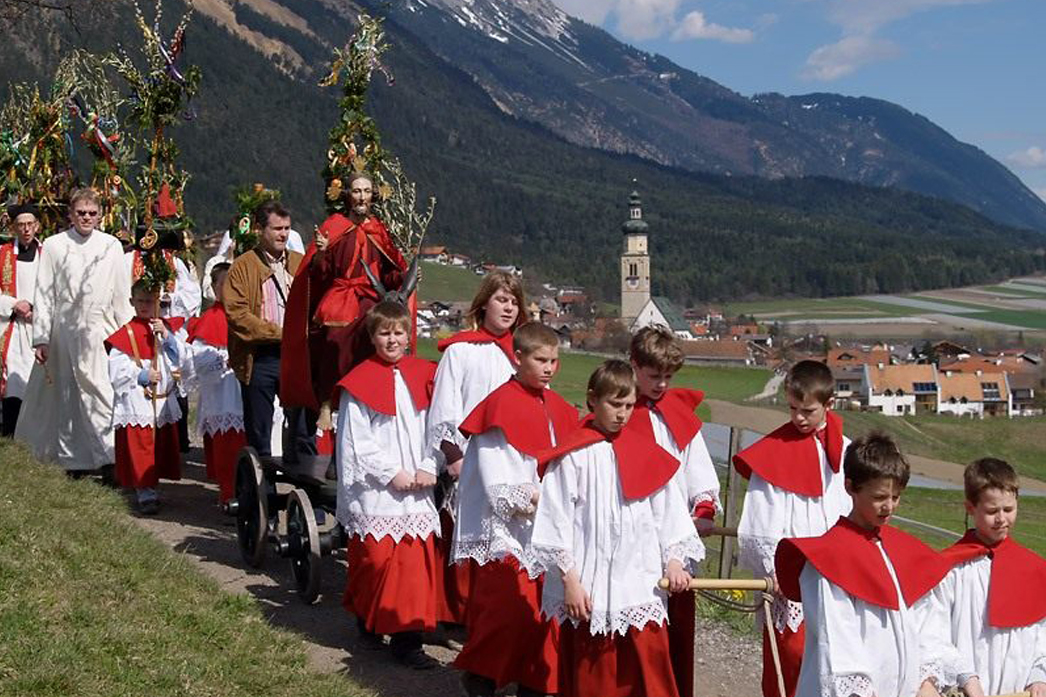The use of a statue of a donkey in connection with Palm Sunday is mentioned for the first time in the 10th century. This was in Augsburg. Hope was to achieve absolution for one’s sins by pulling the ass along.
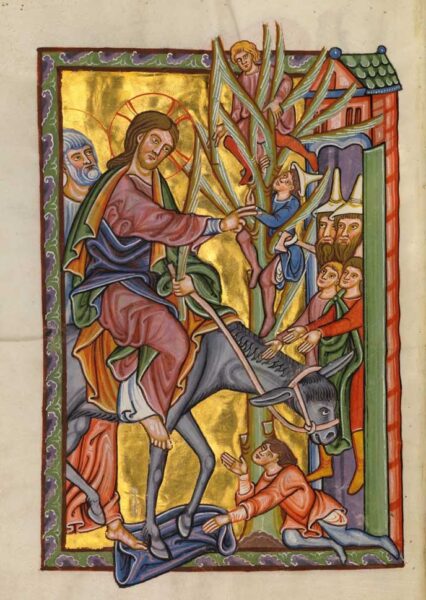
According to all four Gospels, Jesus entered the city of Jerusalem on the fifth day before his crucifixion riding on a donkey. At the same time, people greeted him by waving palms, throwing their capes to the ground to line the road, and chanting the triumphant verses from Psalm 118: “Hosanna to the Son of David! Blessed is he who comes in the name of the Lord! Hosanna in the highest”! Was this the triumphant entry of a King? Had Jesus been a Roman governor or emperor, he would have ridden in a chariot or on a white horse, followed by his mounted retinue signalling power and might. Nevertheless, any might powers would regard the spectacle as disturbing. In Judea more than 2000 years ago, a man coming to town riding on a donkey would not have presented a humble person. A donkey was a status symbol ridden by high-ranking priests or merchants.
On the other hand, the donkey was not a horse. Jesus came as both exalted and in peace while denouncing violence – the donkey is no warhorse. Thus, the Triumphal Entry into Jerusalem was a slap in the face of the powerful elite. And as – we know – rewarded as such in the Easter of AD 33.
Liturgically, this choreographed scene in the narrative of the Passion would end up presenting a challenge for centuries to come. On the one hand, the “Adventus” was a significant part of the story of Jesus as the Messiah. As Matthew records: “All this was done, that it might be fulfilled which was spoken by the prophet, saying, “Tell ye the daughter of Sion, Behold, thy King cometh unto thee, meek [or gentle], and sitting upon an ass, and a colt the foal of an ass.” On the other hand, any ritual reenactment was doomed to call down the wrath of the mighty.
Thus, any reenactment involving donkeys was deemed inappropriate for most of the first Millenium. Although the procession on Palm Sunday with the blessing of palm leaves or olive branches is documented from Jerusalem in Late Antiquity in the pilgrimage of Egeria, the central liturgical elements were the slow procession from one church to another and the blessing of the foliage..
Royal appropriation
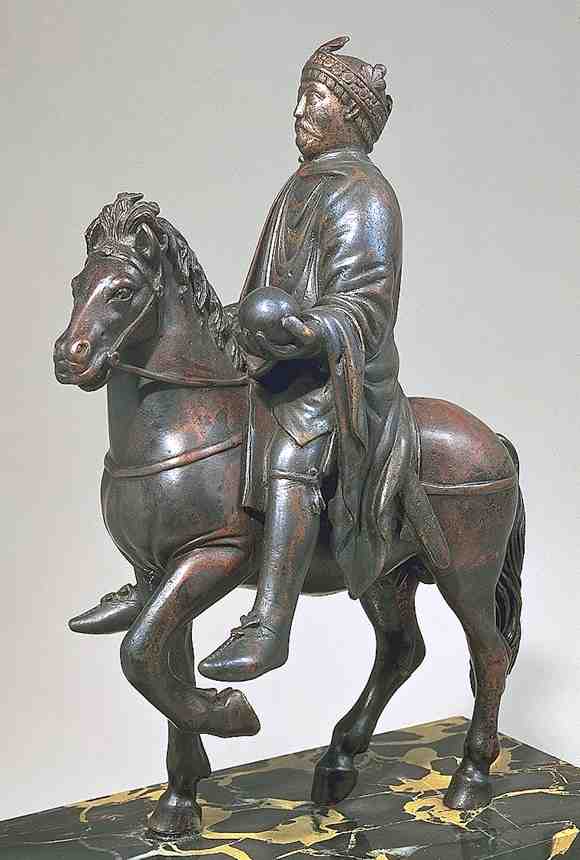
However, the double “meaning” of the story of the Adventus of Jesus offered kings the possibility of gliding into the Palm Sunday celebrations’ liturgical setting. Not entirely “playing Jesus”, they could use the ritual and liturgical setting as a stage for their personal aggrandisement.
Charlemagne seems to have been the first to grasp this opportunity. When he entered Rome at Easter after defeating the Lombardian king in AD 774, he arrived on Good Friday. The event is described in the Vita of Hadrian. Here we are told that Charlemagne was met outside the city by representatives of the fourteen districts of Rome, accompanied by little boys waving palm leaves and olive branches while chanting in acclamation. He was also greeted by men carrying processional crosses – signs and banners – which the Pope had sent out.
Encountering this multitude of people, Charlemagne spontaneously descended from his horse – thus NOT mirroring Caesar – and entered the Holy City through the Flaminian gate. He spent his first night at a hostel inside the walls until the following day when he was greeted by the Pope standing on the steps to St. Peter. Now, Charlemagne was led by the hand to pray at the tomb.
Meanwhile, the clergy and monks chanted his praise, acclaiming “Benedictus qui venit” – “Blessed is he, who comes in the name of the Lord” – the traditional chant of Palm Sunday. Afterwards, the Pope and his royal guest crossed the bridge over the river Tiber to enter the city itself. Again, the choreography was not quite mirroring Jesus entering the Heavenly Jerusalem, but close enough. Charlemagne’s Adventus into Rome and St. Peter seems to have been carefully designed to act as liturgical sanctification of the “new man in town”. The ritual may well have acted as a paradigm for later celebrations of kings and emperors travelling to their “homes” to celebrate Easter.
Wooden Palmesels
Meanwhile, ordinary people continued to celebrate the beginning of the Holy Week by walking in a procession, waving their foliage and seeking its benediction, while at the same time downplaying the triumphal character of the narrative by dispensing with donkeys or horses of any kind. To say the least, the evidence is fragmentary. And yet, it is believed the celebration of Palm Sunday was popular, who was allowed to walk alongside the clergy for once.
Together with the processions at Rogations-tide and at the later Corpus Christi processions, these were the unique situations where lay people were obligatory participants.
Although the procession with palms of foliage was developed in Northern France during the 8th and 9th centuries, it was not until the end of the 10th century, the use of a donkey statue is mentioned.
The first description of a Palmesel is found in the vita of St. Ulrich of Augsburg († 973), which tells us how the saint went from the Cathedral to the church of St. Afra, from where he led a procession back with people waiving Palms and following a wooden sculpture of a donkey.
On that day at dawn [Ulrich] used to come to the church of St. Afra, if he had not already spent the night there. He would sing the mass of Holy Trinity and bless the palm branches and various other foliage. The with the gospel book, and crosses and banners, and with the image of the lord seated on an ass [cum effigie sedentis domini super asinum] with the clergy and a multitude of people carrying palm branches in their hands, and with chants composed in honour of that same day, he proceeded with great splendor to the hill called Perlach. There with everything beautifully done, the choir of canons came to meet him, as well as the citizens, who had remained in the city, and those from the surrounding towns, who wanted to join them there in imitating the humility of the children and the rest of the people who [long ago] strewed the way of the Lord with palm branches and their own clothes. After this, the holy man preached to everyone a most suitable sermon about the Lord’s passion, often weeping himself and by his tears causing many others to weep. When his ermon was finished, everyone came to the Cathedral Church praising God and there celebrated mass with him. Afterwards they all went home.
(As quoted in Christ on a Donkey by Max Harris)
The hope was to achieve absolution for one’s sins by pulling the wooden animal along.
Palmesels were life-size wooden statues showing the donkey which Jesus rode in his triumphant entry into Jerusalem, as recorded by both Mark, Matthew, John and Luke. Often these donkeys were fitted out with life-size statues of the blessing Christ. Until the 15th century, it was considered bad taste to have someone “ride” the donkey, thus impersonating Jesus. Usually, the donkeys were placed on wheels and drawn through the countryside.
At least from the beginning of the 13th century, we know that local churches had natural-sized donkeys sculpted to be used in local processions. The oldest one, dated to c. 1200, is kept in Berlin, while ten are from the 13th to 14th century, while the rest are Late Medieval. The tradition was widespread in Germany, Holland and Belgium.
More than 190 medieval palmesels are said to exist in museums and private collections. 84 are listed in Europeana, although very few a graced with photos

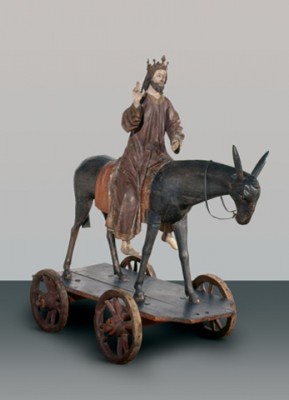
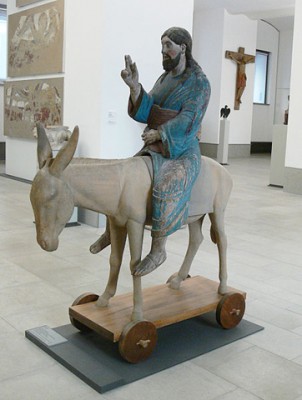
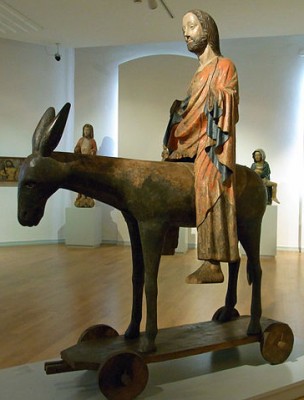
SOURCES:
Christ on a Donkey – Palm Sunday, Triumphal Entries, and Blasphemous Pageants
By Max Harris
Arch Humanities Press 2019
SEE MORE:
